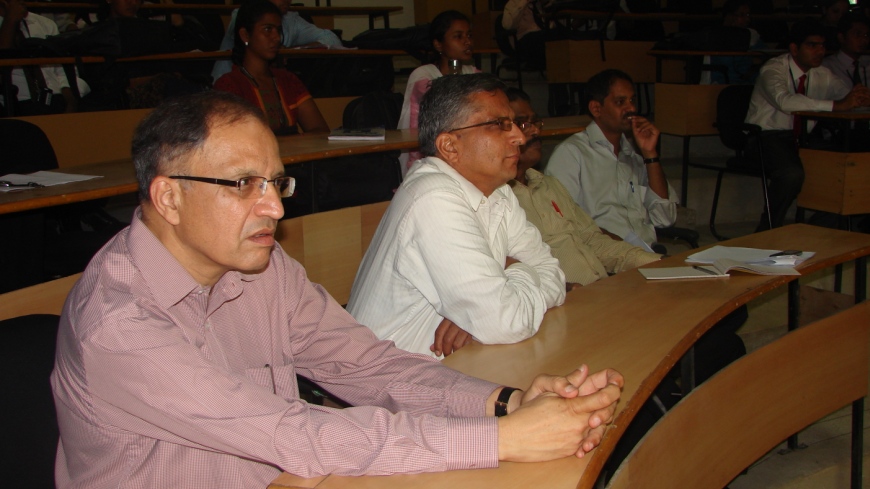
Dialogical Workshop on Spiritual Pragmatism
Topic: Spiritual Pragmatism and A New Geometry of Consciousness
Date: Auguest 28, 2013
Time: 9 am – 1 pm
Venue: Indus Business Academy, Bangalore
Workshop Outline
Spiritual Pragmatism
Pragmatism has been an important philosophical and socio-cultural movement in the US which has influenced our view of language, social reality and human condition. American pragmatism as cultivated by C.S. Pierce and John Dewey has influenced post-war continental philosophy in the works of seekers such as Kar Otto-Apel and Jurgen Habermas. But this has not been merely a one-way influence. In the works of Apel and Habermas we see a mutual dialogue between American pragmatism and streams in continental philosophy namely Kant leading to what is called Kantian pragmatism. Kantian pragmatism has influenced critical theory. Kantian pragmatism has opened up pragmatism to new realities and possibilities as a result of dialogue between American pragmatism and continental philosophy.
But this dialogue now needs to be broadened and needs to be part of what can be called planetary conversations. There is a need for dialogue between varieties of pragmatism and also for exploring spiritual horizons of pragmatism. For example, Confucianism does have an important emphasis upon practice and pragmatism. John Dewey did visit China and did got to know the Confucian streams of theory and practice. Pragmatism does also have a spiritual horizon and base as, for example, in many streams of Indian traditions there is a focus on transformative practice. In this context Sri Aurobindo in his Life Divine talks about a nobler pragmatism “guided, uplifted and enlightened by spiritual culture and knowledge.” In his Human Cycles Sri Aurobindo also talks about spiritual vitalism. Sri Aurobindo also urges us to look at language as mantra and cultivate the mantra dimension of language. This urges us to go beyond a simplistic view of language as reflection of society. This resonates with Martin Heidegger’s conception of language as way making movement. In Sri Aurobindo and Heidegger we find streams of spiritual pragmatism in their meditations on language, self, being and reality which can also inspire us to explore the spiritual struggle in Wittgenstein’s conception of form of life.
With a creative dialogue with Sri Aurobindo, Heidegger, Wittgenstein and Habemas and Dewey, we can cultivate paths of spiritual pragmatism as a new way of looking at self, society, language and reality. In spiritual pragmatism new languages and practices are born of multidimensional sadhana, strivings and struggles touching both the social and spiritual bases of life and society. Spiritual pragmatism involves interpenetration of spiritual and material, immanent and transcendence, capability and transcendence. Spiritual pragmatism involves practical discourse as suggested in the critical theory and practice of Jurgen Habermas and practical spirituality suggested in the works of Swami Vivekananda, Sri Aurobindo as well as in many transformative spiritual movements in societies and histories. Spiritual pragmatism thus contributes to strivings for realization of non-duality as an ongoing sadhana and struggle in life, culture and society. It must be noted that there is an important legacy of overcoming dualism in American pragmatism as well which we notice in the work of social philosophers such as Goerge Herbert Mead who urge us to go beyond the dualism of subject and object.
In our proposed workshop we wish to explore further issues of spiritual pragmatism in the light of concerns shared above. We have been exploring different aspects of spiritual pragmatism over the last years and in the present workshop we would particularly relate it to the vision and practice of a new geometry of consciousness. Spiritual pragmatics calls for cultivation and nurturance of appropriate consciousness and in our workshop we explore this.
Geometry of Consciousness
Idea of consciousness has been explored deeply in the East through a focus on Self and has also drawn attention of the Western thinkers. In exploring it, thinkers and realizers have used varying forms of symbols to represent the full evolution of consciousness from ‘Awareness to Awakening’. For example, various ‘colors of consciousness’ can be represented through the rainbow symbol, red representing ‘self awareness’ and violet representing ‘self awakening’ and in between colors representing various states of self evolution. Further, it may be indicated that ‘full circle rainbow’, that is a rare phenomenon, can be viewed as a geometrical representation of the expanding circles of consciousness. In fact, expansion in consciousness can be represented by various geometrical forms. Geometry of consciousness deals with such representations that find their abundant expression in nature and in various art forms.
Essence of the geometry of consciousness can be represented by three symbols viz. + (plus) , x (multiplication), and spiral. When + (plus) symbol is rotated we get x (multiplication) symbol and when x (multiplication) symbol is rotated at high speed, we get a spiral that can even create a tornado. These three symbols are at the root of the geometry of consciousness that can take varying forms depending upon the speed of rotation.
In social contexts, geometry of consciousness finds its expression through individual and collective consciousness. An individual’s consciousness can transform a society e.g. Gandhi’s impact on society through the combined affect of +, x and spirals of awakening created by him. Similarly collective consciousness of a society can also transform a society e.g. French revolution and Russian revolution. Revolutions can be considered as ‘tornadoes of collective consciousness’ leading to fundamental change in the society and its structure. A better understanding of geometry of consciousness can provide us some lessons in understanding disruptions and transformations in society and nations.
It may be indicated that geometry of consciousness also finds its expression through various languages. An illustration of geometry of consciousness is the very first letter of Devnagri script which is a combination of symbol of infinity and the symbol T . This Devnagri letter can serve as an analytical model of dialectical synthesis wherein symbol of infinity represents thesis and anti-synthesis intertwined like infinity and vertical line representing the dialectical synthesis of thesis and anti-thesis. This illustration from the Devnagri script leads us to a general view that alphabets of various languages represent a geometry of consciousness. Popular usage of the phrase, From Alpha to Omega can also be interpreted in terms of evolution of consciousness from Alpha state to Omega state. In fact, every language is an expression of geometry of consciousness through sound and its underlying connection with various geometrical shapes expressed through alphabets.
In our workshop, we aim at exploring various dimensions of the geometry of consciousness and its implications for human beings, institutions, corporations, nations and society.
Tag:philosophy, workshop
